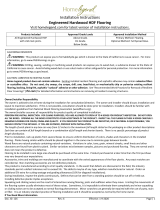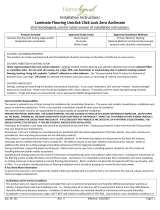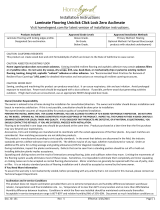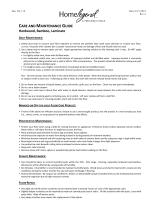•
4.5% when tested using Tramex Concrete Moisture Encounter
•
Less than 3 pounds per 1000 square feet per 24 hours when using Calcium Chloride test (ASTM F 1869)
•
75% when using Relative Humidity Testing (ASTM F-2170).
Please note: Concrete moisture content may be acceptable the time of the test but these tests do not guarantee a perpetual “dry” concrete
slab. The concrete slab moisture content can vary at other times of the year. We are not responsible for moisture related damage to
installed flooring.
Wood Subfloor Requirements
It must be clean; no presence of construction debris, soil, mud and any other objects on or adhering to the floor; no protrusions of nails,
debris, metals should remain. If necessary, scrape and sweep the subfloor before the installation.
It must be structurally sound and stable: no movements or squeaks, no loose panels or loose nails, no signs of ply de-lamination or other
damages. Repair all shortcomings before installation.
It must be flat with no visible bumps or low spots; the subfloor should be flat to within 1/8” in 6 feet span or 3/16” in 10 feet.
Test for moisture using reliable moisture meter. Perform tests at locations around exterior doorways, near foundation walls, near walls
containing plumbing lines and in the center of the room. Measure 20 locations per 1000 square feet.
Moisture content of subfloor should be less than 12%.
Plywood or Oriented Strand Board (OSB) Specifications
On truss/joist spacing of 16” (406mm) O/C or less, the industry standard for single-panel subflooring is minimum 5/8” (19/32”, 15.1 mm) CD
Exposure 1 plywood subfloor panels (CD Exposure 1) or 23/32” OSB Exposure 1 subfloor panels, 4’ x 8' sheets. Expansion gap between panels
should be 1/8” (3 mm). If panels are not tongued and grooved and there is not sufficient spacing or is inadequate, cut in the required spacing
with a circular saw. Do not cut in expansion space on tongue and groove panels.
Particle Board or Fiber Board
Only for floating installation.
Existing Floors
Installation over existing floor requires the installer to consider potential issues related to moisture damage, adhesive failure and fastener
failure. Contact the adhesive and fastener manufacturers respectively for their specific instructions, recommendations and requirements.
Acceptable floor coverings include: solid hardwood, linoleum, terrazzo, ceramic tile and other “moisture sealing floors.”
Unacceptable floor coverings include: carpet, needle punch felt, edge glued linoleum and other “moisture absorbing flooring.”
Radiant Heated Subfloor
This product can be installed over radiant heated subfloor. Operating surface temperature must be less than 84°F. Decrease temperature
before installation. Increase temperature gradually after installation. Glue down installation may require additional installation requirement.
Contact glue manufacturer for specific recommendation. Contact heater manufacturer for specific installation instruction.
Moisture Barrier and Moisture Retarder
Concrete Subfloor: For floating installation, use 6 mil polyethylene film or other means with equivalent permeability. Overlap the edge
seams and tape it together. Extend moisture barrier up to the wall about 1 inch high. When installed on above grade concrete and the
concrete moisture content meets the concrete moisture standard, a moisture barrier is not required. For direct glue installation, use a
moisture barrier if moisture level exceeds requirement (see Concrete Moisture section above).
Wood Subfloor: Use asphalt-saturated kraft paper or #15 or #30 felt that meets ASTM Standard D4869 or UU-B-790, Grade D.
Overlap along the edge seams 2”- 4” wide. This retards moisture movement from below. Extend the moisture retarder to about 1” from the
walls. Secure to the subfloor as necessary.
Sound Control Underlayment
Check with sound control manufacturer for application guidelines. Generally, the less compressive underlayment is preferred.
Expansion Gap
Required gap width is 1/2”. It is required around the perimeter of the floor and between floor and all vertical obstructions. Do not place
permanently installed structures such as kitchen counter/cabinet on the installed floor.
Transition Molding
Floating installation, transition T-molding is required in the following cases: floor spanning greater than 35 feet in length or width; doorways
or passageways 5 ft. wide or less.
Note: Floor areas interrupted by wall openings greater than 5 ft. wide, or interrupted by wall sections extending out of the wall, or floor areas
which are not rectangular may experience buckling or gapping if there is excessive floor expansion or shrinkage.
Adhesive
Use premium flooring adhesive which is non-water based, formulated for hardwood flooring installation.
Preferred type: moisture cure urethane floor glue.




























